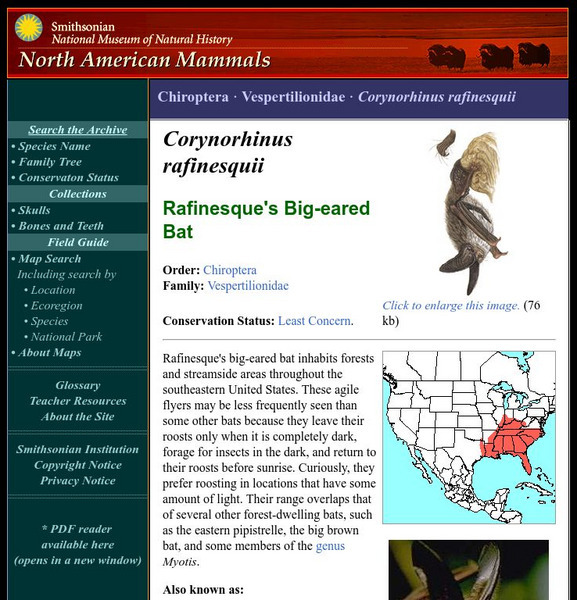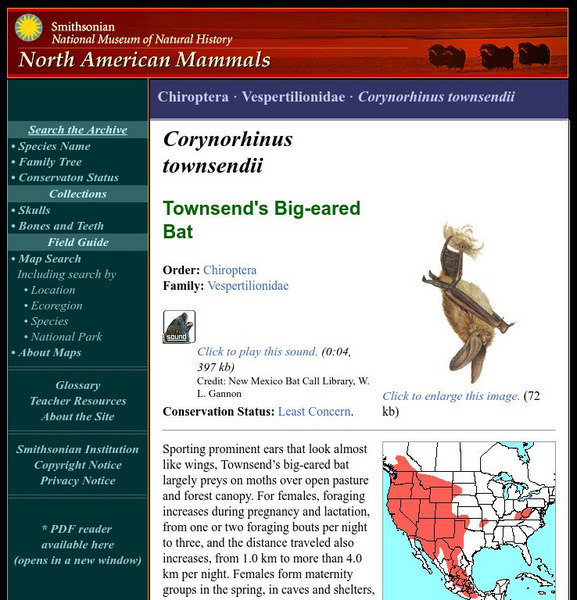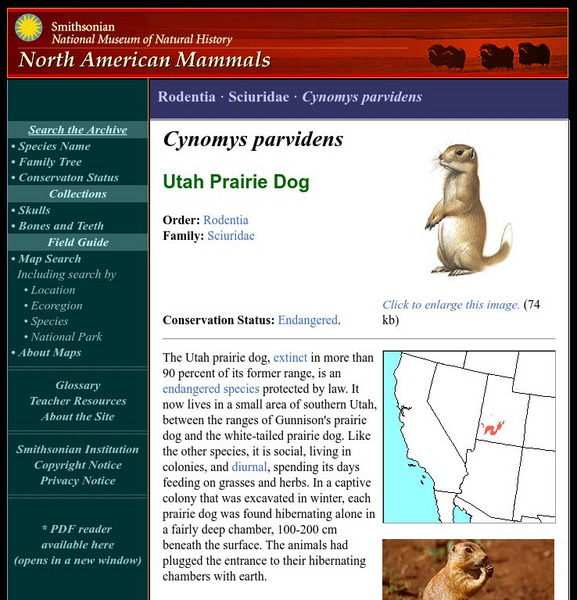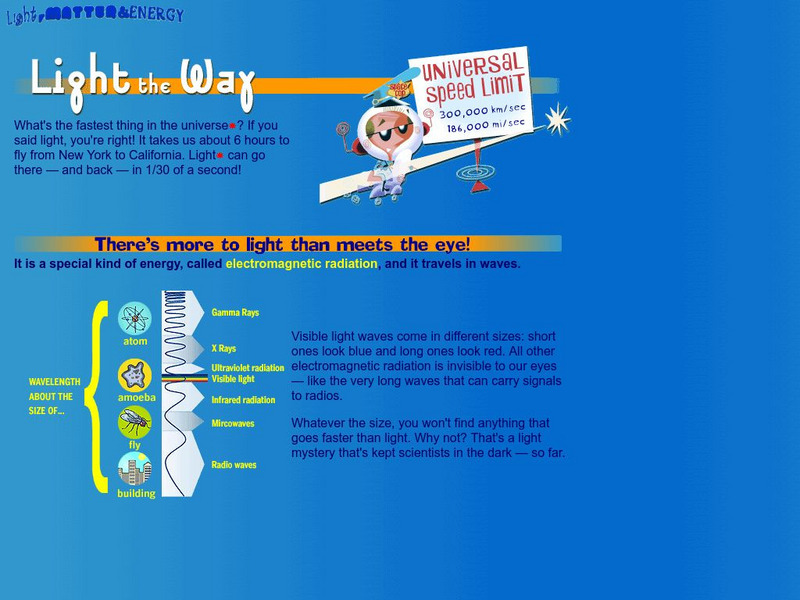Smithsonian Institution
National Museum of Natural History: American Mammals: Hispid Pocket Mouse
"Hispid" refers to the coarseness of this pocket mouse's fur. Hispid Pocket Mice are larger and more robust than other pocket mice in their range, and like the others, they are solitary except in the breeding season. Learn more about the...
Smithsonian Institution
National Museum of Natural History: American Mammals: Western Pocket Gopher
As is the case with a number of pocket gopher species, most aspects of the Western Pocket Gopher's life have not yet been studied. This Pocket Gopher lives in rich volcanic soils of alpine meadows and small glacial prairies, west of the...
Smithsonian Institution
National Museum of Natural History: American Mammals: Northern Pocket Gopher
Of all North American pocket gophers, the Northern Pocket Gopher has the widest distribution, across most of the western United States and south-central Canada, and it occurs in the greatest variety of habitats. Only habitats with a...
Smithsonian Institution
National Museum of Natural History: American Mammals: Southern Pocket Gopher
Because most Southern Pocket Gophers live at high elevations in the mountains of Mexico, they are less accessible, and have been less-studied, than some other species. Like all pocket gophers, they are vegetarians, consuming both...
Smithsonian Institution
National Museum of Natural History: American Mammals: Mountain Pocket Gopher
Mountain Pocket Gophers live in meadows, pastures, and rocky slopes, in pine, fir, spruce, and hemlock forests at elevations above 1,545 m. They are active all year, and like other pocket gophers, they are solitary. Learn more about the...
Smithsonian Institution
National Museum of Natural History: American Mammals: Desert Pocket Mouse
The Desert Pocket Mouse is a common inhabitant of warm deserts throughout the United States and Mexico. It prefers sandy soil and avoids rocky settings, and like other pocket mice, comes out at night to search for seeds. Learn more about...
Smithsonian Institution
National Museum of Natural History: American Mammals: Western Red Bat
This close cousin to the eastern red bat (Lasiurus borealis) is genetically distinct. These bats are found along the west coast and the southwestern US and into Mexico where they are thought to hibernate in the winter. Learn more about...
Smithsonian Institution
National Museum of Natural History: American Mammals: Mexican Long Tongued Bat
Mexican long-tongued bats feed on fruits, pollen, nectar, and probably insects. The populations that summer in the United States migrate to Mexico and northern Central America in winter, following the blooming cycle of plants such as...
Smithsonian Institution
National Museum of Natural History: American Mammals: Rafinesque's Big Eared Bat
Rafinesque's big-eared bat inhabits forests and streamside areas throughout the southeastern United States. These agile flyers may be less frequently seen than some other bats because they leave their roosts only when it is completely...
Smithsonian Institution
National Museum of Natural History: American Mammals: Townsend's Big Eared Bat
Sporting prominent ears that look almost like wings, Townsend's big-eared bat largely preys on moths over open pasture and forest canopy. For females, foraging increases during pregnancy and lactation, from one or two foraging bouts per...
Smithsonian Institution
National Museum of Natural History: American Mammals: Utah Prairie Dog
The Utah prairie dog, extinct in more than 90 percent of its former range, is an endangered species protected by law. It now lives in a small area of southern Utah, between the ranges of Gunnison's prairie dog and the white-tailed...
Smithsonian Institution
National Museum of Natural History: American Mammals: White Tailed Prairie Dog
White-tailed prairie dogs are threatened in many places because they have been the target of pest control programs. They live in burrow colonies made up of groups of females and young. Learn more about the Cynomys leucurus, more commonly...
Smithsonian Institution
National Museum of Natural History: American Mammals: Virginia Opossum
The Virginia opossum, the only marsupial found north of Mexico, is an adaptable omnivore at home on the ground and in the trees. Opossums prefer forested habitats, but they are quite successful even in urban areas. Learn more about the...
Smithsonian Institution
National Museum of Natural History: American Mammals: Pallid Bat
Common throughout its range, the pallid bat occurs in arid and semi-arid regions throughout northern Mexico and the western United States. Pallid bats eat beetles, grasshoppers, and moths, and they forage for slow-moving prey, such as...
Smithsonian Institution
National Museum of Natural History: American Mammals: Spotted Bat
Conspicuous and distinctive, with three highly visible white spots on its black back, and larger-than-life ears for its body size, the spotted bat would doubtless be the object of more human attention if it flew during the day. As it is,...
Smithsonian Institution
National Museum of Natural History: American Mammals: Steller Sea Lion
Steller sea lions are divided into two groups for conservation purposes. Those that live around Alaska and Russia are classified as endangered. Learn more about the Eumetopias jubatus, more commonly known as a Steller Sea Lion, in this...
Smithsonian Institution
National Museum of Natural History: American Mammals: Greater Bonneted Bat
Greater Bonneted Bats live in rugged, rocky canyons typical of the arid Southwest, where they inhabit crevices in vertical cliffs. Because of their relatively large body size and narrow wings, these bats are unable to take off from a...
Smithsonian Institution
National Museum of Natural History: American Mammals: Mexican Ground Squirrel
Mexican Ground Squirrels have adapted well to human activity and are common inhabitants of roadsides, cemeteries, and golf courses. They are omnivores, feeding on the seeds of a variety of grasses and forbs, green plant material, and...
Smithsonian Institution
National Museum of Natural History: American Mammals: Long Eared Myotis
With its long, luxurious fur, which can range in color from dark brown to pale yellow, and its large, coal-black ears, the long-eared myotis is a striking animal. Long-eared myotis prefer roosting in rock outcroppings and dead trees....
San Diego Natural History Museum
San Diego Natural History Museum: Mineral Matters: Grow Your Own Crystals
Here are step-by-step instructions on how to create crystals. This is a great experiment for students to use in learning about the structure and formation of crystals.
American Museum of Natural History
American Museum of Natural History: O Logy: Stuff to Do: Drawing Dinosaurs
A tutorial on how to draw a realistic dinosaur starting from a picture of a skeleton.
American Museum of Natural History
American Museum of Natural History: O Logy: Light, Matter, Energy: Light the Way
What is electromagnetic radiation and how does it work? Review a captioned graphic that explains electromagnetic radiation and the visible and invisible types of radiation on the electromagnetic spectrum.
American Museum of Natural History
American Museum of Natural History: O Logy: All About Cloning
Learn what cloning is, how it works, what animals have been cloned, and about Dolly, the first mammal (a sheep) to be cloned from an adult cell. Click on the links to see flash cards on the topics.
American Museum of Natural History
American Museum of Natural History: O Logy: You Light Up My Life!
Brief explanation of observations that Arthur Eddington used to test Einstein's general theory of relativity. Click on the starred words to learn more about the topic.























